World Press Photo: a journey across ‘the other side of the world’
More than 73,000 photographs were received by the organisers of the World Press Photo this year, from more than 4,500 photographers in some 125 countries. A tiny selection, the winners chosen by jury in eight categories, are on display until early October in the TU/e building Vertigo. Cursor asked a few visitors about their favorite.
Almost thirty people are being given a tour by curator Yi Wen Hsia at the start of the World Press Photo exhibition. She offers a glimpse of how the exposition was put together (this year with the new Environment category, "that theme is simply unavoidable "), of the choices made by the jury (“if we were to let ten different juries choose, we'd get ten different exhibitions”) and the choices made by the photographers.
One of the photographs that Hsia discusses is the winner in the Hard News category, Ronaldo Schemidt, who captured a burning protestant in Caracas, the Venezuelan capital. Not intentionally, incidentally, according to the curator: the photographer was standing with his back to the man when he suddenly felt a tremendous heat approaching him. “He turned round and clicked. Only ten seconds later did he realize it was a burning man.”
Something he would later be criticized for, she tells us, as often happens to photographers when asked why in certain circumstances they took photos instead of helping. Whereas this photo, by contrast, was a contributing factor in this man getting help, after it appeared in the news, and getting seventy operations, according to Hsia, “after people set up a crowdfunding campaign for him”.
The rise of the extreme right in the United States, medical tourism in Thailand, the worldwide battle against waste, men from two English villages in battle during their annual three-day game of 'medieval' rugby - all are depicted in the exposition. A brief “world trip”, Hsia calls the exhibition, that wants to make people aware of the kind of things going on in the world. The World Press Photo 2018 can be seen in Vertigo until October 4.
'The girls seem almost to be drowning in the regime under which they are living'
For Robert van Dongen, who this year hopes to graduate from Industrial Engineering and Management Sciences, there is little doubt. Chiefly drawing his eye is the photo series of girls and women in the Zanzibar archipelago who are learning to swim dressed in long garments - despite years of discouragement from within the conservative Islamic culture.
The bottom right photo in particular, of the swimming teacher who is clicking with her fingers while disappearing under the water, intrigues the student. It expresses hope and strength, feels Van Dongen - in contrast to the primary feeling that the other photos stir in him of “girls who are almost literally drowning in the regime under which they are living”. Although the caption says the teacher is dipping below the surface, the movement that the student sees in the image is an upwards one, symbolic of “a feeling of change for the good”.
It makes him remember his good fortune to be born here, in the Netherlands. “Those women live in a world where they are told what they can do and what they can think. Set that against the fact that having the scope to develop yourself and to set out your own path are things I find so important.” ‘Joyful self-development’, is what he calls his quest: “If you're working on that, then you are occupied with the greatest gift we have - which is having this life and being allowed to live it.”
'We must not close our eyes to misery'
“I have to say I find it all rather miserable.” Hennie Zondag from Tiel, visiting - and today accompanied by - friends from Eindhoven, sighs as she walks from one panel to the next. Not that she isn't realistic, she will later point out: “There simply is a lot of misery; we must not close our eyes to it.”
Nonetheless she chooses a photograph with a positive feeling as her favorite. In the middle stand two unmarried brothers, photographed in a traditional Chinese yaodong or ‘house cave’. It gives a glimpse of “a very different world”, feels Zondag, in which the men appear to be completely content. “They look happy. Given my own background, I couldn't manage to live there, but they are happy with very few things. That laptop, on the other hand, I find really striking and funny.” Another appealing feature, she feels, is that the image leaves the viewer room for interpretation. “For almost everything in the photo, you can ask yourself, What is this for? What they are watching, for example; at any rate, it's a fun picture.”
The dog reminds her of the dog in ‘The Night Watch’ by Rembrandt - as indeed the entire image is reminiscent of a painting by a Dutch master. The work of Frisian artist Jopie Huisman also comes to (her) mind. In any case, for Zondag, who nonetheless is full of praise for the whole exhibition, painting generally has more appeal than photography. “I am fascinated by the process in which something is created. These all capture just a single moment.”
'I am fortunate to have the opportunities I do'
The painting-like style of the Chinese brothers also jumps out for the Indonesian Architecture PhD candidate Dany Perwita Sari, in Eindhoven for only the past two weeks. Together with her compatriot and Master' student Puji Sri Ningsih, she is visiting a World Press Photo exhibition for the first time. The expo gives a good impression of “the other side of the world”, she feels, which even as a 'traveler off the beaten track' you wouldn't get to know.
The photo of the brothers fascinates Sari (on the right in the photograph) due to the contradictions it contains - not least thanks to the open laptop (“the search for connections with the rest of the world”) in the middle of what for the rest seem like primitive conditions. “They look happy. It is a real feel-good photo.”
Similarly, the photo series on the panel behind, of Russian prostitutes in all their vulnerability, makes an impression on the Indonesian. These are women like herself, Sari says, many of them with a good brain, some even with promising diplomas to their name, who nonetheless have ended up in the sex industry. “Then I feel fortunate to have been born where I was and to have the opportunities I do.”
'It is a very impressive, surreal image'
Don Keijzers (Mechanical Engineering) and Ruben van Dijk (Architecture) take plenty of time on Wednesday afternoon to explore the exposition. Yet having had a good look round, they choose the photo by the entrance, by the Venezuelan photographer Ronald Schemidt mentioned above, as their favorite. It shows José Victor Salazar Balza running, after his body caught fire during fighting with the riot police at a protest against president Maduro in Caracas.
It is a very surreal image, think both the students - as are the photos on the reverse of the main panel, by a different photographer, made at the same moment. “Almost as if the fire on the skin has been photoshopped.” Keijzers (on the left in the photo) points to the black gun on the wall, a detail that underlines the violence. “I find it a really impressive image.” He himself recently spent 18 months in South America and although he did not go to Venezuela, he says he did pick up a lot about the tumultuous political situation in the country. "That brings it all closer to home for me."
Van Dijk is also intrigued by the portraits of the girls who were abducted by Boko Haram in Nigeria, but who managed to escape (see the photo at the top of this article). “The photos are a little mysterious, minimalistic. After a first glance you don't know what story lies behind them. That appeals to me.”
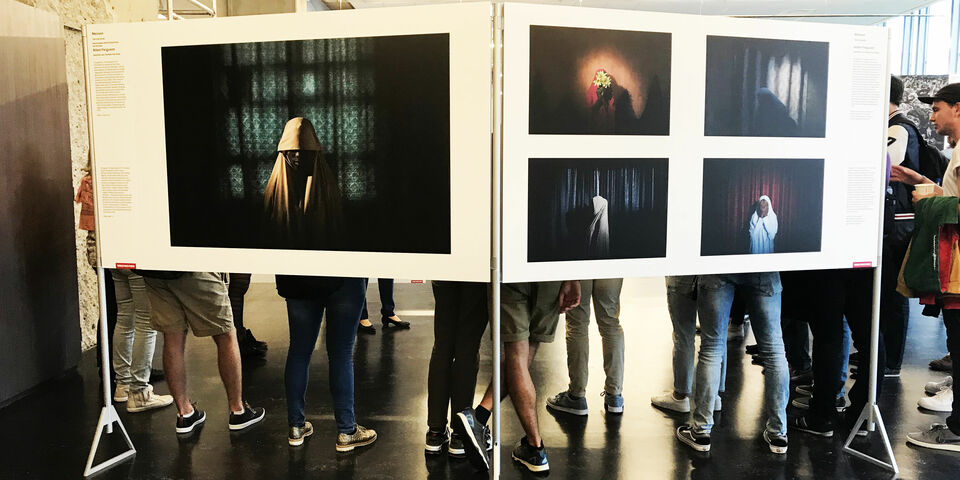

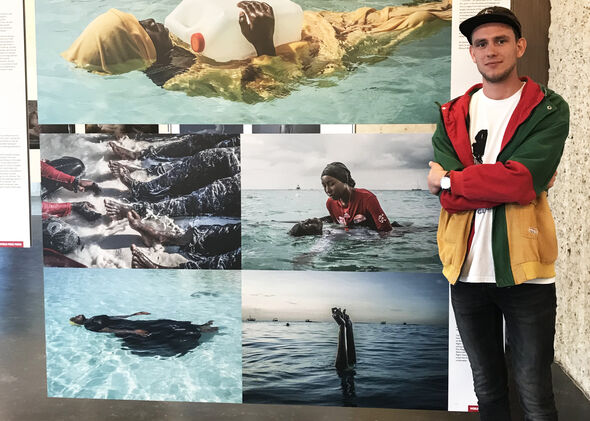
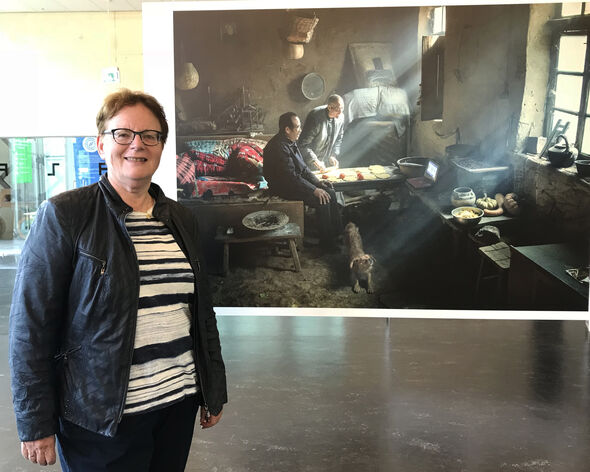
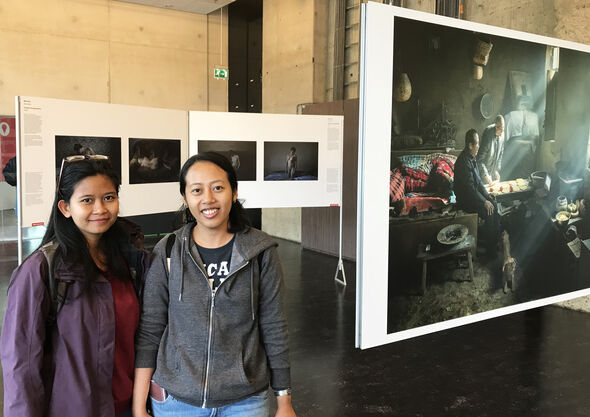
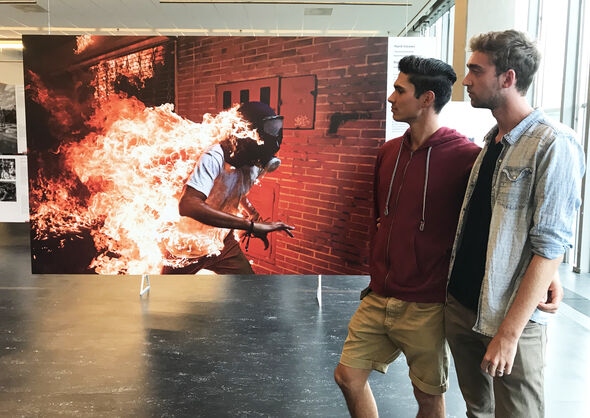
Discussion